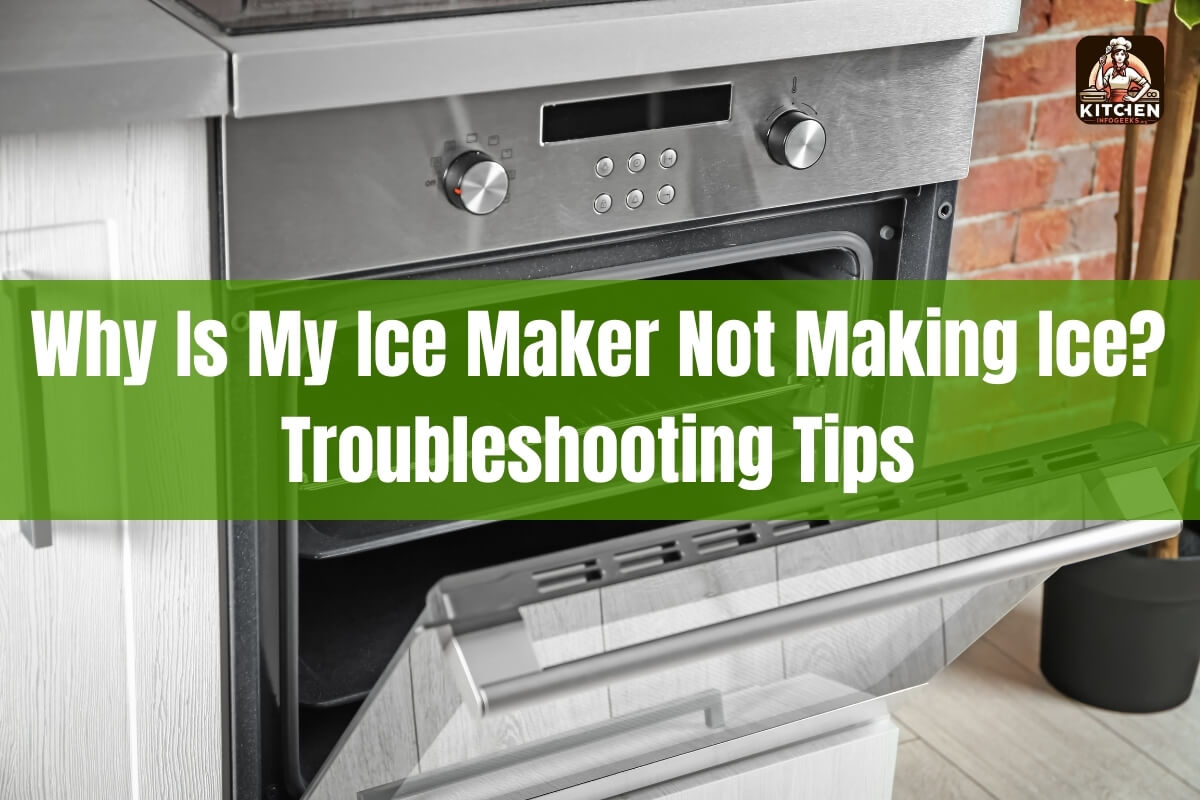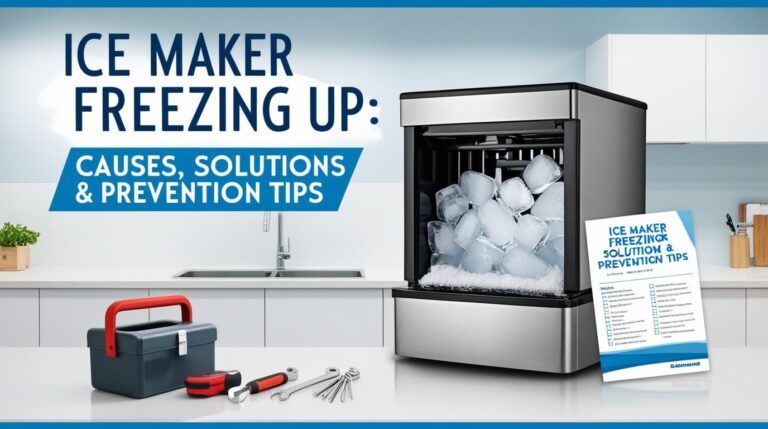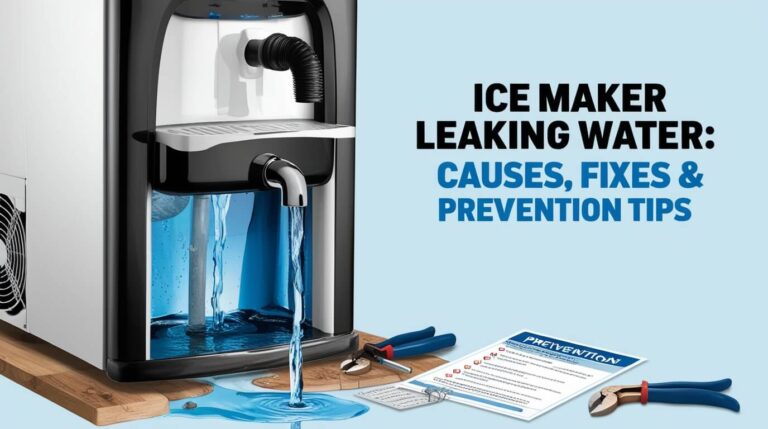
If your refrigerator’s ice maker has stopped producing ice, it can be a frustrating situation. Don’t panic – there are several common causes, and many of them have simple solutions you can try yourself before calling for professional repairs.
In this comprehensive guide, we’ll explore the top reasons why your ice maker may not be making ice and provide step-by-step troubleshooting tips to get it working again. From clogged water filters to temperature issues, we’ll cover it all.
Common Causes of an Ice Maker Not Making Ice
There are several potential reasons why your ice maker might stop producing ice cubes. Here are some of the most common culprits:
Clogged Water Filter
The water filter in your refrigerator plays a crucial role in providing clean water to the ice maker. However, over time, these filters can become clogged with sediments and particles, restricting water flow to the ice maker.
Low Water Pressure
For an ice maker to function correctly, it requires a specific water pressure range (typically between 20 and 120 psi). If the water pressure is too low, the ice maker won’t receive enough water to produce ice cubes.
Faulty Water Inlet Valve
The water inlet valve is responsible for controlling the water flow to the ice maker. If this valve malfunctions or becomes clogged, it can prevent water from reaching the ice maker, causing it to stop producing ice.
Frozen or Blocked Water Line
The water line that supplies water to the ice maker can freeze or become blocked, preventing water from reaching the ice maker. This issue is often caused by low temperatures or kinks in the water line.
Door Switch Issues
Many refrigerators have a door switch that turns off the ice maker and dispenser when the freezer door is opened. If this switch is faulty, it can prevent the ice maker from functioning correctly.
Control Arm Out of Position
Some ice makers have a control arm that senses when the ice bin is full and stops ice production. If this arm is out of position or broken, it can cause the ice maker to stop making ice or produce too much ice.
Ice Maker Turned Off or Paused
In some cases, the ice maker may simply be turned off or in a paused state. Check the control panel or refer to your owner’s manual to ensure the ice maker is turned on and not in a paused mode.
Freezer Temperature Set Too Low
If the freezer temperature is set too low, it can cause the water line or other components to freeze, preventing the ice maker from functioning correctly.
Heating Element Failure
Most ice makers have a heating element that helps release the ice cubes from the tray. If this heating element fails, the ice maker won’t be able to eject the ice cubes, leading to a lack of ice production.
How to Fix a Clogged Water Filter
A clogged water filter is a common issue that can cause your ice maker to stop producing ice. Here’s how to fix it:
- Locate the water filter in your refrigerator (refer to your owner’s manual if needed).
- Remove the old water filter and inspect it for clogs or sediment buildup.
- Replace the old filter with a new one, following the manufacturer’s instructions.
- Flush the water line by running water through the dispenser for a few minutes to remove any residual sediments.
Checking Water Pressure for Ice Makers
Low water pressure can prevent your ice maker from receiving enough water to produce ice cubes. Here’s how to check the water pressure:
- Turn off the water supply to the refrigerator.
- Locate the water inlet valve at the back of the refrigerator.
- Disconnect the water line from the valve and place a bucket underneath to catch any water.
- Turn the water supply back on and check the flow of water into the bucket.
- The water pressure should be between 20 and 120 psi for proper ice maker operation.
- If the water pressure is low, you may need to call a plumber to address the issue.
Replacing a Faulty Water Inlet Valve
If the water inlet valve is faulty, it will need to be replaced. Here’s how to do it:
- Turn off the water supply to the refrigerator and unplug the appliance.
- Locate the water inlet valve at the back of the refrigerator.
- Disconnect the water line and any electrical connections from the valve.
- Remove the valve by unscrewing it or releasing any mounting clips.
- Install the new valve, following the manufacturer’s instructions.
- Reconnect the water line and any electrical connections.
- Turn the water supply back on and check for any leaks.
Troubleshooting a Frozen or Blocked Water Line
If the water line that supplies water to the ice maker is frozen or blocked, you’ll need to take action to restore the water flow. Here are some options:
Using a Hair Dryer to Defrost
If you can access the frozen water line, you can use a hair dryer to carefully apply heat and defrost the line. Be cautious not to overheat or damage any surrounding components.
Letting It Thaw by Turning Ice Maker Off
In some cases, simply turning off the ice maker for 24 hours can allow the frozen water line to thaw on its own.
Unplug Refrigerator to Defrost Line
As a last resort, you can unplug your refrigerator and allow it to defrost completely. This should melt any ice buildup in the water line, but it may take several hours, and you’ll need to find an alternative way to keep your food cold during this time.
Issues with the Freezer Door Switch
If the freezer door switch is faulty, it can prevent the ice maker from functioning correctly. Here’s how to troubleshoot this issue:
- Check the door switch by opening and closing the freezer door while listening for a clicking sound.
- If the switch doesn’t click or seems to be sticking, you may need to replace it.
- Consult your owner’s manual or contact the manufacturer for instructions on replacing the door switch.
Checking and Resetting the Control Arm
The control arm is a vital component that regulates ice production based on the level of ice in the bin. Here’s how to check and reset it:
- Locate the control arm – it’s usually a plastic or metal arm that rests on top of the ice bin.
- Ensure the control arm is in the correct position and can move freely.
- If the control arm is stuck or broken, you may need to replace it.
- Some ice makers have a reset button or process that can be initiated by pressing and holding a specific button (refer to your owner’s manual for instructions).
Adjusting Freezer Temperature for Ice Production
The freezer temperature plays a crucial role in ice production. Here’s what you need to know:
Recommended Freezer Temp Settings
Most manufacturers recommend setting the freezer temperature between 0°F and 5°F (-18°C and -15°C) for optimal ice production.
Effects of Temperature Being Too High or Low
If the freezer temperature is set too high (above 5°F/-15°C), it can prevent the ice maker from producing ice cubes or cause them to be small and misshapen.
If the temperature is set too low (below 0°F/-18°C), it can cause the water line or other components to freeze, preventing the ice maker from functioning correctly.
Resetting the Ice Maker after Temp Change
After adjusting the freezer temperature, you may need to reset the ice maker to resume ice production. Consult your owner’s manual for specific instructions, as the reset process can vary between models.
Signs of a Failing Heating Element
The heating element in your ice maker is responsible for releasing the ice cubes from the tray. If this element fails, you may notice the following signs:
No Ice Production at All
If the ice maker isn’t producing any ice cubes, even though water is reaching the tray, it could be a sign of a failed heating element.
Testing the Heating Element
You can test the heating element with a multimeter to check if it’s receiving power and functioning correctly. However, this process can be complex and may require professional assistance.
When to Call for Professional Repairs
While many ice maker issues can be resolved with basic troubleshooting, some situations may require the assistance of a professional appliance repair technician:
- If you’ve tried all the troubleshooting steps and the ice maker still isn’t working
- If you’re uncomfortable working with electrical components or plumbing
- If you suspect a more complex issue, such as a problem with the ice maker’s control board or compressor
Calling a professional can save you time and ensure the issue is properly diagnosed and repaired. A trained technician will have the expertise, tools, and experience to identify and fix even the most stubborn ice maker problems efficiently.
If you’ve exhausted all the troubleshooting options and still can’t get your ice maker to work, it’s best to avoid further guesswork or disassembly attempts that could potentially cause more damage. Instead, contact a reputable appliance repair service to have a professional take a look.
Similarly, if you’re not confident working with electrical components or making plumbing connections, it’s safer and wiser to leave those tasks to a professional. Attempting DIY repairs on these types of components can be risky and may even void your appliance’s warranty.
In cases where the issue appears to be more complex, such as a malfunctioning control board or compressor, it’s generally recommended to seek professional assistance right away. These types of repairs often require specialized tools, diagnostic equipment, and technical expertise that most homeowners don’t have access to.
Tips for Preventing Future Ice Maker Issues
While some ice maker problems are inevitable due to normal wear and tear, there are several steps you can take to help prevent issues and extend the lifespan of your ice maker:
Changing Water Filter Regularly
As mentioned earlier, a clogged water filter can significantly impair your ice maker’s performance. To prevent this issue, be sure to change your refrigerator’s water filter every six months or according to the manufacturer’s recommendations.
Keeping Freezer at Proper Temperature
Maintaining the appropriate freezer temperature is crucial for optimal ice production and preventing issues like frozen water lines. Regularly check your freezer’s temperature and adjust it as needed to stay within the recommended range.
Ensuring Control Arm Moves Freely
If your ice maker has a control arm, make sure it can move freely and isn’t obstructed by anything in the ice bin. A stuck or broken control arm can lead to issues with ice production or overflow.
Checking Water Line Periodically
Inspect the water line that supplies your ice maker every few months for any signs of kinks, damage, or freezing. Addressing these issues promptly can prevent more significant problems from developing.
By following these preventive measures, you can help ensure your ice maker continues to function reliably and efficiently, providing you with a steady supply of ice for all your cold beverage needs.
Conclusion
An ice maker that’s not producing ice can be a frustrating problem, but as you’ve learned, many of the causes have straightforward solutions. By methodically troubleshooting common issues like clogged water filters, low water pressure, temperature problems, and component failures, you can often get your ice maker up and running again without the need for professional repairs.
Remember, prevention is key. Regularly maintaining your refrigerator, changing the water filter, and keeping an eye on the freezer temperature can go a long way in avoiding ice maker issues altogether.
If you’ve tried all the troubleshooting steps and your ice maker still isn’t making ice, or if you’re dealing with a more complex issue, don’t hesitate to call in a professional appliance repair technician. They have the expertise and tools necessary to diagnose and fix even the most stubborn ice maker problems efficiently.
With the right approach and a little patience, you can ensure that your ice maker continues to provide a steady supply of ice, keeping your beverages cool and refreshing for years to come.






